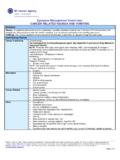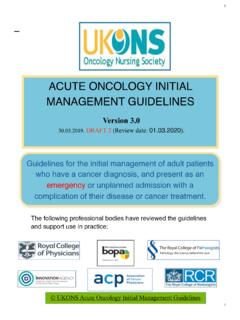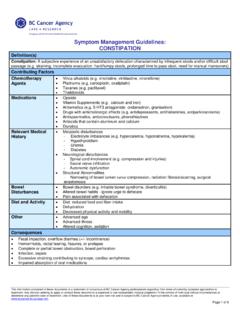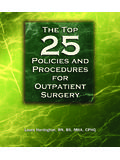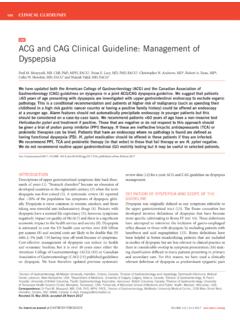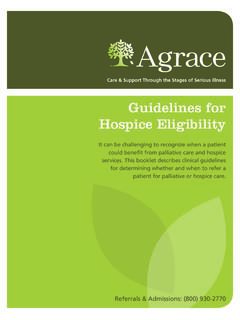Transcription of Hypersensitivity & Infusion Reaction Management
1 2019 Hypersensitivity & Infusion Reaction Management Guide SCC PHARMACY UPDATED 1 Table of Contents Reaction 2 General Signs and Symptoms of Reactions .. 2 Infusion Reactions .. 2 Anaphylaxis Reactions .. 2 Grading of Reactions .. 4 Infusion Reactions .. 4 Anaphylactic Reactions .. 4 Immediate steps .. 5 Treatment of mild to moderate reactions .. 5 Re-challenge .. 5 Acute Management .. 6 Adjunctive therapies .. 6 Documentation of Infusion Reaction .. 7 References .. 7 Pager Instructions .. 8 2 Reaction Management General Signs and Symptoms of Reactions The most common signs and symptoms are cutaneous ( , sudden onset of generalized urticaria, angioedema, flushing, and pruritus). However, 10-20% of patients have no skin findings. Danger signs: Rapid progression of symptoms, respiratory distress ( , stridor, wheezing, dyspnea, increased work of breathing, persistent cough, cyanosis), vomiting, abdominal pain, hypotension, dysrhythmia, chest pain, collapse.
2 Infusion Reactions These is common with taxanes, rituximab, bleomycin, daratumumab, PEGylated liposomal doxorubicin and daunorubicin, trastuzumab, immunotherapy (list), brentuximab, ofatumumab, panitumumab. Related to the administration of the chemotherapy, the agent may or may not have an allergic component. Infusion reactions may affect any organ system in the body. Most are mild in severity, although severe and even fatal reactions occur. The most common signs and symptoms of Infusion reactions are: Flushing Itching Alterations in heart rate and blood pressure Dyspnea or chest discomfort Back or abdominal pain Fever and/or shaking chills Nausea, vomiting, and/or diarrhea Various types of skin rashes Throat tightening Hypoxia Seizures Dizziness and/or syncope Anaphylaxis Reactions These are common with platinum agents, asparaginase, etoposide, cetuximab, alemtuzumab. Reactions usually occur during or within a few hours of drug Infusion .
3 Although they occur most commonly with the first or second drug administration, Infusion reactions are unpredictable and can occur at any time despite preventive measures (especially with platinum agents). 3 The most common signs and symptoms of anaphylaxis caused by intravenously administered medications are the following: CUTANEOUS SYMPTOMS Flushing, itching, urticaria, and/or angioedema (usually of face, eyelids, or lips) RESPIRATORY SYMPTOMS Repetitive cough, sudden nasal congestion, shortness of breath, chest tightness, wheeze, sensation of throat closure or choking, and/or change in voice quality (due to laryngeal edema), hypoxia CARDIOVASCULAR SYMPTOMS Faintness, tachycardia (or less often bradycardia), hypotension, hypertension and/or loss of consciousness GASTROINTESTINAL SYMPTOMS Nausea, vomiting, abdominal cramping, and/or diarrhea NEUROMUSCULAR SYMPTOMS Sense of impending doom, tunnel vision, dizziness, and/or seizure, severe back, chest, pelvic pain Although there is overlap between the clinical features of anaphylaxis and those of Infusion reactions, certain signs and symptoms are highly suggestive of anaphylaxis, and they should be specifically sought out when evaluating a patient with an Infusion Reaction .
4 Urticaria, repetitive cough, wheeze, throat tightness/change in voice, and hypotension. These stereotypical signs and symptoms result from the release of mediators from mast cells and basophils. In contrast, fever and prominent muscular pain are NOT features of anaphylaxis, and the presence of these signs and symptoms suggests the Reaction is an Infusion Reaction . It is critical to undress the patient and examine the skin carefully during reactions to fully appreciate skin findings, especially urticaria. The neck, trunk, extremities, abdomen, and axillae are the sites where urticaria often appears first. 4 Grading of Reactions Infusion Reactions NCI CTCAE Infusion Related Reactions Adverse Event Infusion Related Reaction Grade 1 Mild transient Reaction ; Infusion interruption not indicated; intervention not indicated Grade 2 Therapy or Infusion interruption indicated but responds promptly to symptomatic treatment (eg, antihistamines, NSAIDs, narcotics [opioids], (intravenous fluids); prophylactic medication indicated for less than or equal to 24 hours Grade 3 Prolonged (eg, not rapidly responsive to symptomatic medication and/or brief interruption of Infusion ); recurrence of symptoms following initial improvement; hospitalization indicated for other clinical sequelae Grade 4 Life-threatening consequences.)
5 Urgent intervention indicated Grade 5 Death Infusion -related Reaction is characterized by adverse Reaction to the Infusion of pharmacological or biological substances NCI CTCAE: National cancer Institute Common Terminology Criteria for Adverse Events; NSAIDs: nonsteroidal anti-inflammatory drugs. Anaphylactic Reactions NCI CTCAE Anaphylaxis Reaction Adverse Event Anaphylaxis Grade 1 Grade 2 Grade 3 Symptomatic bronchospasm, with or without urticaria; parenteral intervention indicated; allergy-related edema/angioedema; hypotension Grade 4 Life-threatening consequences; urgent intervention indicated Grade 5 Death Anaphylaxis is characterized by an acute inflammatory Reaction resulting from the release of histamine and histamine-like substances from mast cells, causing a Hypersensitivity immune response. Clinically, it presents with breathing difficulty, dizziness, hypotension, cyanosis, and loss of consciousness and may lead to death.
6 5 Patients with mild signs or symptoms of anaphylaxis should not be re-exposed to the causative agent until they have been evaluated by the attending physician. In particular, these patients should NOT be considered candidates for additional premedication and an attempt at drug re-administration using a slower rate of Infusion unless specified by the prescribing physician. Desensitization protocols should only be attempted is the drug cannot be substituted for a clinically equivalent option. Immediate steps 1. Stop the Infusion 2. Maintain access 3. ABCs: Airway, Breathing, Circulation 4. Assess level of consciousness 5. Vital signs 6. If blood pressure Trendelenburg position 7. Oxygen if needed If further measures needed, EMSA to be called. Treatment of mild to moderate reactions Mild to moderate Infusion reactions (ie, National cancer Institute [NCI] Grade 1, Grade 2) and Infusion reactions that do not involve symptoms of anaphylaxis can usually be managed with temporary interruption of the Infusion and symptom Management .
7 All the necessary medications are in the Infusion Reaction bags; these are available on each nursing unit. Refer to Paclitaxel and Rituximab Protocols for patients that appropriate for re-challenge on the titration protocol. Re-challenge Alert an attending before re-challenge attempt. NCI CTCAE Allergic Reaction Adverse Event Allergic Reaction Grade 1 Systemic intervention not indicated Grade 2 Oral intervention indicated Grade 3 Bronchospasm; hospitalization indicated for clinical sequelae; intravenous intervention indicated Grade 4 Life-threatening consequences; urgent intervention indicated Grade 5 Death Allergic reactions are characterized by adverse local or general responses from exposure to an allergen. NOTE: If related to a drug Infusion , use the grading scheme for Infusion -related Reaction . 6 After all symptoms have resolved, re-challenge with a reduced Infusion rate and additional premedication is usually successful. Following a severe Infusion Reaction (NCI Grade 3 or higher), re-challenge is usually discouraged.
8 This is particularly true if the SIR included any symptoms suggestive of an allergic Reaction , such as urticaria or angioedema H1/H2 antagonists: diphenhydramine 50 mg plus famotidine 20 mg Corticosteroids equivalent dose to 125 mg of (methyl) prednisolone once. May be repeated in 4-6 hours if needed. Acute Management Reactions with any features of anaphylaxis or severe Infusion reactions (NCI Grade 3 or higher) require discontinuation of the drug Infusion and immediate treatment with epinephrine (see dose below) and antihistamines. The first and most important treatment in anaphylaxis is epinephrine. o There are NO absolute contraindications to epinephrine in the setting of anaphylaxis. Airway: Immediate intubation if evidence of impending airway obstruction from angioedema. Delay may lead to complete obstruction. o Intubation can be difficult and should be performed by the most experienced clinician available. EMSA should be called immediately if an experienced clinician is not available.
9 Promptly and simultaneously, give IM epinephrine (1 mg/mL preparation): Give epinephrine to mg intramuscularly, preferably in the mid-outer thigh. Can repeat every 5 to 15 minutes (or more frequently), as needed. If epinephrine is injected promptly IM, most patients respond to one, two, or at most, three doses. After second dose, physician to be called. Use discretion on inpatient EMSA being called and admission/observation for the patient. Normal saline rapid bolus Treat hypotension with rapid Infusion of 1 to 2 liters IV. Repeat, as needed. Massive fluid shifts with severe loss of intravascular volume can occur. Albuterol (salbutamol): For bronchospasm resistant to IM epinephrine, give to 5 mg of albuterol in 3 mL saline via nebulizer. Repeat, as needed. Restart Infusion at 50% rate and titrate to tolerance (If no Grade 3 or 4) For patients who have recurrent SIRs despite premedication, desensitization protocols have allowed for continued use of the drug in some cases.
10 Adjunctive therapies H1 antihistamine*: Give diphenhydramine 50 mg IV (for relief of urticaria and itching only). H2 antihistamine*: Give famotidine 20 mg IV. Glucocorticoid*: Give methylprednisolone 125 mg IV. 7 Monitoring: Continuous noninvasive hemodynamic monitoring and pulse oximetry monitoring should be performed. Urine output should be monitored in patients receiving IV fluid. Resuscitation for severe hypotension or shock. Documentation of Infusion Reaction How To Document An Infusion Reaction (IR) PRE- Infusion ASSESSMENT Drug Number of cycles Reintroduction of treatment (Yes/No) Relevant medical history/allergy/atopy Concomitant medication Oral premedication correctly taken RELEVANT INFORMATION OF THE IR EVENT Infusion rate Premedication Timing of symptom onset Vital signs Symptoms/signs Standard grading (CTCAE) Management Intervention Time to symptom resolution Patient response Reintroduction (Yes/No) Rate reintroduction References Up to Date CTCAE, Common Terminology Criteria for Adverse Events Management of Infusion reactions to systemic anticancer therapy: ESMO Clinical Practice Guidelines (2017) 8 Pager Instructions Co v erage Begins M arch 1 , 2 0 1 9 Co v erage Ends: TBD 1.


